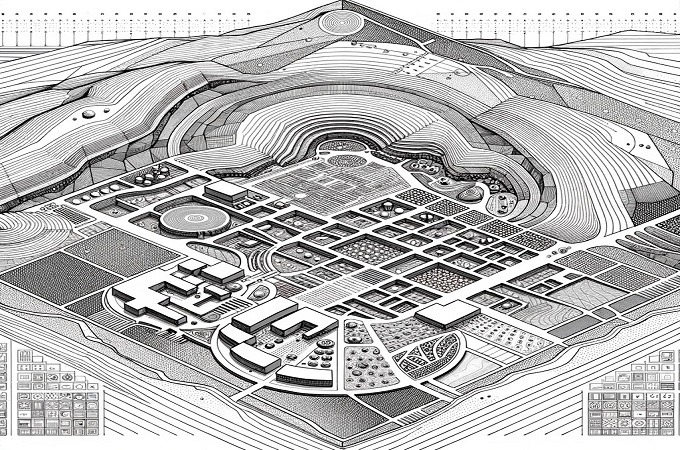Göbekli Tepe
In the southeastern region of Turkey, atop a mountain ridge, lies one of archaeology’s most enigmatic and awe-inspiring discoveries: Göbekli Tepe. Often referred to as the world’s oldest temple, this prehistoric site has challenged long-held beliefs about the dawn of civilization and the evolution of religious practices. Unearthed only a few decades ago, Göbekli Tepe’s intricate stone pillars and carvings beckon with mysteries that have yet to be fully deciphered.
As we delve deeper into the history, significance, and architecture of this ancient marvel, we’ll explore how this site, dating back over 12,000 years, might just reshape our understanding of humanity’s early chapters. So, whether you’re an ardent history enthusiast or someone simply fascinated by ancient wonders, join us on this journey through time, as we unravel the enigmas of Göbekli Tepe.
- Historical Background: The Dawn of Göbekli Tepe
- Architectural Marvels of Göbekli Tepe
- The Significance of the Carvings at Göbekli Tepe
- Göbekli Tepe and its Influence on Ancient Civilizations
- The Mystery Surrounding its Abandonment
- Preservation and Tourism: Safeguarding Göbekli Tepe for the World
- Recent Discoveries and Ongoing Research: Peeling Back the Layers of Göbekli Tepe
- Göbekli Tepe: Bridging Millennia with Stone and Mystery
Historical Background: The Dawn of Göbekli Tepe
In the annals of archaeological discovery, few sites have elicited as much excitement and intrigue as Göbekli Tepe. Located in the Anatolian region of southeastern Turkey, this monumental site was first brought to the world’s attention in the mid-1990s by German archaeologist Klaus Schmidt. However, its significance had been overlooked for decades, with initial surveys in the 1960s dismissing it as merely a medieval burial ground.
The true age and importance of Göbekli Tepe became apparent through extensive excavations and carbon dating. Radiocarbon analysis revealed that this site dates back to the Late Epipaleolithic period, approximately 9600-7300 BCE. This places Göbekli Tepe’s construction at a time long before the advent of settled agriculture, the construction of cities, or the invention of writing.
What makes Göbekli Tepe’s historical background particularly captivating is its stark departure from conventional archaeological wisdom. Traditionally, it was believed that large religious complexes or temples were the result of complex societies with established agricultural practices. Yet, Göbekli Tepe seems to defy this narrative. Hunter-gatherer communities, not established agricultural societies, constructed the massive megalithic pillars, some of which weighed up to 20 tons.
The site comprises several circular and oval-shaped stone enclosures, with each subsequent layer suggesting different phases of construction. The massive T-shaped limestone pillars are arranged in circles, with two larger central pillars surrounded by smaller ones. These pillars are adorned with a diverse array of carvings, from wild animals to abstract symbols, offering a glimpse into the spiritual and cultural milieu of the time.
While much about Göbekli Tepe remains shrouded in mystery, its historical background serves as a testament to the capabilities and aspirations of early human societies. It challenges our understanding of the Neolithic Revolution, pushing us to reconsider the sequence of social and technological developments that led to the rise of civilization.
Architectural Marvels of Göbekli Tepe
Göbekli Tepe is not just an archaeological wonder due to its age, but also because of its staggering architectural achievements. At the heart of this ancient site stand massive T-shaped limestone pillars, which showcase the brilliance and ambition of its builders.
The T-Shaped Pillars
These iconic pillars are the defining feature of Göbekli Tepe. Ranging in height from 3 to 6 meters, many of these pillars weigh in excess of 10 tons. The sheer size and weight of these monoliths raise intriguing questions: How were pre-agrarian societies able to transport and erect such massive stones without the aid of modern machinery or even beasts of burden?
Intricate Carvings
The surfaces of these pillars are not just plain stone; they are canvases that bear intricate carvings of animals, birds, and abstract symbols. From foxes, lions, and snakes to birds of prey, the detailed reliefs provide valuable insights into the fauna of the region and possibly the spiritual or mythological beliefs of the builders.
Circular Layouts
The pillars are arranged in circular formations, typically with two taller central pillars surrounded by a ring of shorter ones. This layout is recurrent across Göbekli Tepe, suggesting a deliberate architectural choice. The purpose and significance of this design remain subjects of intense debate among scholars, with theories ranging from astronomical alignments to ritualistic gatherings.
Layered Construction
Over time, older circles at Göbekli Tepe were buried, and newer ones built atop them. This deliberate act of burying and rebuilding hints at a cyclical nature of rituals or ceremonies, or perhaps a method of preserving older structures.
Use of Non-Local Stones
Analysis of the pillars has shown that while many were constructed using local limestone, some were made from stones sourced from regions several kilometers away. This indicates a level of planning, organization, and possibly trade or cooperation between distant communities.
Absence of Residential Structures
Interestingly, Göbekli Tepe doesn’t show evidence of permanent habitation. The absence of residential buildings, cooking areas, or storage facilities suggests that the site was primarily, if not exclusively, of religious or ceremonial importance.
The architectural marvels of Göbekli Tepe stand as a testament to the ingenuity and determination of early humans. These structures, built thousands of years before the pyramids of Egypt or Stonehenge, challenge our understanding of ancient civilizations and their capabilities. They push us to rethink the narrative of human progress, highlighting a chapter where hunter-gatherers reached for the sky, leaving behind stone giants to tell their tale.

The Significance of the Carvings at Göbekli Tepe
The stone pillars of Göbekli Tepe are not merely impressive for their size and number, but for the intricate carvings that adorn them. These reliefs, rich in symbolism and detail, provide a rare window into the beliefs, myths, and perhaps even the daily life of the people who constructed this ancient site.
A Menagerie in Stone
A diverse array of animals is depicted across the pillars, from wild boars and foxes to cranes and scorpions. The meticulous attention to detail in these carvings suggests a deep familiarity with the regional fauna. It’s possible that these animals held totemic significance, representing clans, deities, or spirits.
Symbolic Interpretations
Beyond the immediately recognizable animal figures, Göbekli Tepe also features a variety of abstract symbols, including H-shaped motifs, crescents, and serpentine forms. While their exact meanings remain elusive, these symbols may represent celestial objects, religious concepts, or elements of the natural world.
Narratives and Myths
Some researchers speculate that the arrangement of carvings on specific pillars might represent narratives or myths. For instance, scenes with animals chasing each other could depict hunting scenes, spiritual journeys, or cosmological tales. Deciphering these potential stories could offer profound insights into the spiritual beliefs and moral values of the builders.
Ritual and Ceremony
Given the lack of residential structures at Göbekli Tepe, it’s widely believed that the site served primarily as a place of worship or ritual. The carvings may have played a role in these ceremonies, serving as focal points for storytelling, prayer, or dance. Their repeated motifs across various pillars could indicate shared myths and beliefs across generations.
A Reflection of Social Hierarchy
Certain pillars, especially the central ones in each circle, are more elaborately decorated than others. This differentiation might hint at a societal hierarchy, with particular pillars representing leaders, deities, or ancestors of special significance.
Evolution of Artistic Expression
The carvings at Göbekli Tepe, in their sophistication and variety, showcase an early form of artistic expression. They represent not just the aesthetic values of the time, but also the cognitive development of humans in abstract thinking and symbolism.
The carvings at Göbekli Tepe, while enigmatic, are vital keys to unlocking the mindset of prehistoric societies. They challenge us to bridge the vast temporal gap and connect with our ancestors, understanding their fears, hopes, and beliefs. As we continue to study and interpret these ancient reliefs, we edge closer to unraveling the tapestry of myths and truths that the pillars of Göbekli Tepe have safeguarded for millennia.
Göbekli Tepe and its Influence on Ancient Civilizations
Göbekli Tepe’s monumental architecture and intricate carvings are an undeniable testament to the capabilities of its builders. However, its influence may stretch beyond the confines of its stone circles. As researchers continue to excavate and study this site, there’s growing speculation about how Göbekli Tepe might have played a pivotal role in shaping the trajectory of ancient civilizations.
A Cultural Nexus
Given its prominent location and significant size, Göbekli Tepe could have served as a meeting place for various tribes and clans. It’s conceivable that people traveled from distant regions to participate in rituals, trade, or share knowledge. This convergence of diverse groups could have facilitated the spread of ideas, technologies, and cultural practices.
Catalyzing the Agricultural Revolution
Some scholars posit a fascinating theory: that the construction and upkeep of Göbekli Tepe required a stable food supply, leading to the domestication of plants and animals. If true, the site could be directly linked to the Neolithic Revolution, where humans transitioned from hunting and gathering to agriculture, laying the groundwork for settled civilizations.
Spread of Architectural Techniques
The advanced construction methods showcased at Göbekli Tepe might have influenced architectural developments in other regions. As people visited and left the site, they could have carried with them knowledge about stone quarrying, transportation, and construction, seeding the foundations for other monumental structures across the ancient world.
Spiritual and Mythological Impact
The symbols and narratives carved into Göbekli Tepe’s pillars might have contributed to the mythologies of later civilizations. Elements of these stories, or the beliefs they represent, could be precursors to myths found in Sumerian, Babylonian, or even Egyptian cultures.
Formation of Socio-Religious Hierarchies
The organization required to build Göbekli Tepe suggests a degree of social stratification, with leaders, planners, and specialized laborers. This early form of societal hierarchy, possibly centered around religious or ritualistic leaders, might have set the template for priestly or royal classes in nascent civilizations.
Legacy in Art and Symbolism
The artistic style and symbols found at Göbekli Tepe can be seen as early examples of artistic conventions that permeated ancient art. While direct links are challenging to establish, similarities in motifs between Göbekli Tepe and later archaeological sites hint at a shared artistic heritage.
While Göbekli Tepe stands as a marvel in its own right, its true significance may lie in its broader influence on the tapestry of ancient civilizations. As a beacon of human achievement during the dawn of complex societies, it offers a glimpse into the shared heritage and interconnectedness of ancient cultures, reminding us of the enduring human quest for understanding, expression, and connection.
Read More: Lost Civilizations
The Mystery Surrounding its Abandonment
One of the most tantalizing aspects of Göbekli Tepe is not just its construction but its deliberate burial. Thousands of years ago, for reasons still unknown, this monumental site was intentionally covered up with earth and debris, effectively freezing it in time. This act of abandonment, coupled with the site’s meticulous preservation, raises a multitude of questions and theories.
A Ritualistic Burial
One prevalent theory is that the burying of Göbekli Tepe was a ritualistic act. Just as the site’s construction might have had religious significance, its intentional burial could represent a form of ceremonial closure, marking the end of one era or the culmination of certain rituals.
Protection from Invaders
Given its prominence, Göbekli Tepe might have attracted the attention of rival tribes or groups. Burying the site could have been a strategic move to protect its sacred spaces from desecration or to hide valuable artifacts from potential invaders.
Natural Disasters
Some scholars speculate that the region around Göbekli Tepe could have experienced natural calamities like earthquakes or droughts. The community might have buried the site as a propitiatory act, hoping to appease deities or spirits and restore balance to their environment.
Societal Shifts
As societies evolved, religious beliefs and practices could have transformed. Göbekli Tepe, with its deep-rooted spiritual significance, might have become misaligned with new ideologies or religious paradigms, leading to its deliberate burial as a way of ushering in new beliefs.
Preservation for Posterity
Another intriguing theory posits that the site’s burial was an act of preservation. Understanding the significance of what they had built, the people of the time might have chosen to protect Göbekli Tepe from the ravages of time, weather, and human intervention, intending for future generations to rediscover it.
Epidemics or Diseases
While more speculative, it’s conceivable that the community around Göbekli Tepe experienced outbreaks of diseases or epidemics. The site’s abandonment and burial could have been a desperate act to contain the spread or to quarantine affected areas.
In the end, while we can piece together clues from the archaeological record, the exact reasons for Göbekli Tepe’s abandonment remain shrouded in mystery. What’s undeniable is that this act of concealment has, paradoxically, allowed the site to endure, granting us a pristine window into a distant past and leaving us with enigmas that continue to captivate the world.
Preservation and Tourism: Safeguarding Göbekli Tepe for the World
Since its rediscovery in the latter half of the 20th century, Göbekli Tepe has emerged as not just a focal point for archaeological research, but also as a magnet for tourists from around the globe. Balancing the demands of preservation with the interests of tourism presents both challenges and opportunities.
UNESCO World Heritage Site
In 2018, Göbekli Tepe was inscribed on the UNESCO World Heritage List, cementing its status as a site of outstanding universal value. This designation has bolstered efforts to conserve and protect the site while promoting sustainable tourism.
Protective Measures
To shield the ancient carvings and pillars from the elements, protective canopies have been erected over key excavation areas. These shelters mitigate the impact of rain, wind, and sunlight, helping to preserve the intricate details of the stonework for future generations.
Controlled Access
Given the site’s archaeological significance, certain areas of Göbekli Tepe are restricted to the general public. Visitors are guided along specific pathways to ensure minimal disturbance to ongoing excavations and to protect the ancient structures from wear and tear.
Educational Endeavors
Interpretive centers and museums have been established near the site, offering visitors a deeper understanding of Göbekli Tepe’s history, significance, and mysteries. Through interactive exhibits, guided tours, and multimedia presentations, tourists can immerse themselves in the world of this ancient marvel.
Boosting Local Economy
The influx of tourists has revitalized the local economy. From accommodations and eateries to artisanal crafts and guided tours, the communities surrounding Göbekli Tepe have benefited from the global interest in the site.
Sustainable Tourism Initiatives
In collaboration with global and local organizations, efforts are underway to promote sustainable tourism at Göbekli Tepe. This includes minimizing environmental impact, supporting local businesses, and ensuring that tourism revenues contribute to preservation efforts.
Future Prospects
Plans are in motion to enhance the visitor experience further. These include the development of augmented reality tours, expanded educational facilities, and improved infrastructure, all while prioritizing the site’s conservation.
Göbekli Tepe stands as a testament to the intricate dance between preserving the past and embracing the present. As it welcomes visitors from all corners of the globe, the challenge lies in ensuring that this ancient sanctuary remains undisturbed, its stories and mysteries intact for generations to come.

Recent Discoveries and Ongoing Research: Peeling Back the Layers of Göbekli Tepe
Göbekli Tepe, with its sprawling expanse and layered history, remains a goldmine for archaeologists and researchers. Every year, new discoveries are made, each offering a fresh perspective on this ancient site and further deepening its enigma.
1. Unearthed Pillars: Recent excavations have revealed additional T-shaped pillars, some bearing carvings distinct from previously discovered motifs. These pillars, concealed for millennia, provide valuable insights into the evolving artistic and spiritual practices of the site’s builders.
2. Advanced Geophysical Surveys: Modern technology, including ground-penetrating radar and magnetic resonance imaging, is being employed to map the site’s subterranean features. These tools have identified potential undiscovered enclosures and structures, hinting at the vastness of Göbekli Tepe still waiting to be uncovered.
3. Analysis of Toolmarks: Detailed studies on the toolmarks left on the pillars and stones have provided insights into the construction techniques and tools used. This research suggests a level of sophistication and specialization in the workforce that was previously underestimated.
4. Organic Material Studies: Analysis of organic residues and plant remains has shed light on the diet, agriculture, and possibly even the ritualistic practices of the people associated with Göbekli Tepe. There’s growing evidence that they had knowledge of plant cultivation long before the widespread adoption of agriculture.
5. Symbol Decipherment: Scholars are using comparative mythology and linguistics to interpret the symbols and carvings at Göbekli Tepe. While definitive conclusions remain elusive, some motifs are drawing parallels with symbols found in other ancient cultures, suggesting shared mythological themes.
6. Settlement Exploration: While Göbekli Tepe itself lacks evidence of permanent habitation, recent excavations in the surrounding region have identified settlements that might have been contemporaneous with the site. Studying these settlements can offer a holistic view of the social, economic, and cultural landscape of the era.
7. Environmental and Climate Studies: By examining soil samples, sediment layers, and other environmental markers, researchers are reconstructing the climate and ecology of the region during Göbekli Tepe’s active years. This data can provide context to the site’s construction, use, and eventual abandonment.
In essence, Göbekli Tepe is like a vast jigsaw puzzle, with pieces scattered across time and terrain. With every discovery and research breakthrough, the picture becomes a tad clearer, yet the full image remains tantalizingly out of reach. The dedication of archaeologists, historians, and scientists ensures that the story of Göbekli Tepe continues to unfold, capturing the imagination of people worldwide.
Göbekli Tepe: Bridging Millennia with Stone and Mystery
Nestled atop a hill in southeastern Turkey, Göbekli Tepe stands as a sentinel of human history, its stone pillars reaching out across millennia. This ancient sanctuary, older than Stonehenge or the Egyptian pyramids, challenges our understanding of early human societies and their spiritual quests. From its architectural marvels to the intricate carvings, every aspect of this site beckons with tales of dedication, belief, and community.
As we’ve journeyed through its historical background, delved into its architectural wonders, pondered the significance of its carvings, and marveled at its influence on ancient civilizations, one truth becomes evident: Göbekli Tepe is more than just a collection of stones. It’s a testament to humanity’s timeless urge to connect, understand, and transcend.
The mysteries surrounding its construction and abandonment, coupled with the ongoing research and discoveries, ensure that Göbekli Tepe remains a vibrant topic of discussion and exploration. As the world continues to grapple with its enigmas, this ancient site serves as a poignant reminder of our shared heritage, urging us to look back as we move forward, finding inspiration in the achievements of our ancestors.
As visitors flock to witness its grandeur and researchers toil to uncover its secrets, Göbekli Tepe stands resilient, a bridge between the past and the present, echoing with whispers of a time long gone, yet profoundly relevant to our collective journey.






